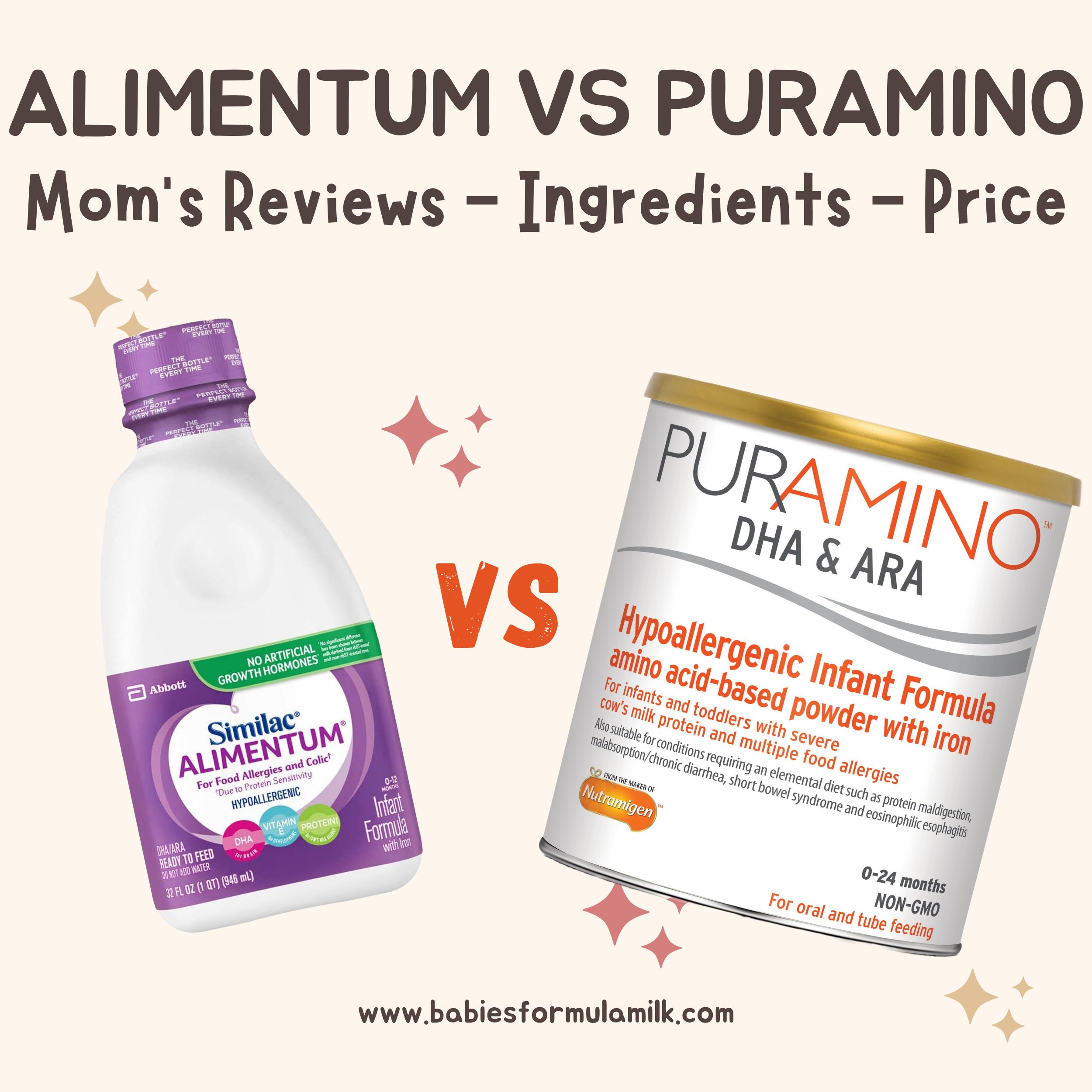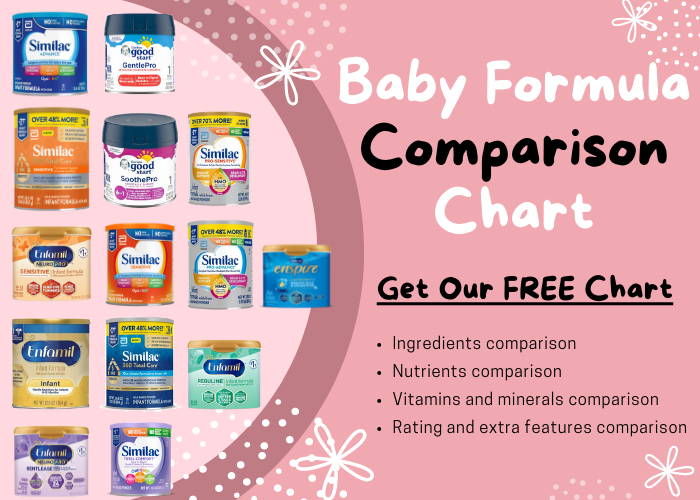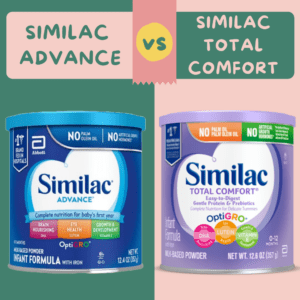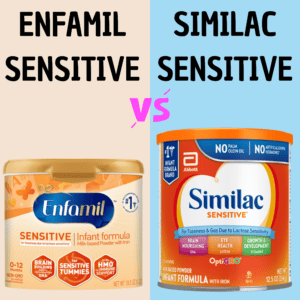What is The Difference?

Alimentum RTF is an extensively hydrolyzed formula made from cow’s milk proteins that have been broken down into smaller, less allergenic fragments. It is lactose-free, making it suitable for babies with lactose sensitivity. The hydrolyzed proteins in Alimentum RTF are easier for babies with cow’s milk protein allergy or sensitivity to tolerate. It is often recommended for infants with mild to moderate cow’s milk protein allergy, lactose intolerance, or sensitivity to intact proteins.
On the other hand, Puramino is an amino acid-based formula, which means that the proteins are broken down into individual amino acids. It is entirely free from cow’s milk proteins, soy, and other common allergens. Puramino is used for infants with severe cow’s milk allergy, multiple food allergies, or those who have not responded well to extensively hydrolyzed formulas like Alimentum RTF.
The Best One?
The optimal formula between Alimentum and Puramino varies depending on your baby’s individual needs and specific health concerns.
Alimentum ready-to-feed is an extensively hydrolyzed formula designed to address mild to moderate allergies, including gas, spit-up, colic, and fussiness. It is a recommended initial choice if your baby has a cow’s milk or lactose allergy, as it is more cost-effective compared to Puramino.
On the other hand, Puramino is an amino acid formula specifically formulated for infants with severe allergies or adverse reactions to extensively hydrolyzed formulas. Puramino has shown positive outcomes in managing issues such as reflux, gas, eczema, tummy problems, and even blood in stools. Additionally, it aids in promoting healthy weight gain in babies. However, due to its higher cost, it is generally considered the last option to consider.
Mom’s Reviews Comparison:

Alimentum RTF has received positive reviews from moms for its effectiveness in reducing gas, spit-up, colic, and fussiness in babies. Moms find it easy to use, which is a plus.
However, some moms have noted that Alimentum RTF is expensive, though still cheaper than Puramino. Additionally, it can be challenging to travel with due to its premade nature. Some babies may also experience constipation, and the taste isn’t very pleasant.
Puramino has been praised by moms for its positive impact on reflux, gas, stomach issues, eczema, and blood in stools. Many moms have observed that it helps their babies gain weight.
However, similar to Alimentum RTF, Puramino is also considered expensive. While the taste and smell may not be very pleasant, it is still preferred compared to other elemental formulas. Some babies may experience constipation and spit-up issues with Puramino. Another challenge reported by moms is that it can be hard to find in stores.
Related: Alimentum RTF Vs EleCare: Which one is The Best (With Charts)
Ingredients Comparison:
Protein Source:
Alimentum RTF and Puramino differ significantly in terms of their protein sources.
Alimentum RTF is an extensively hydrolyzed formula, which means that the protein (casein) in cow’s milk has been broken down into smaller fragments, making it easier for babies with cow’s milk protein allergies or sensitivities to tolerate. The hydrolyzed proteins are less likely to trigger an allergic reaction in infants, making Alimentum RTF a suitable option for those with mild to moderate cow’s milk protein allergies.
In contrast, Puramino is an amino acid-based formula, which means that the proteins in cow’s milk have been broken down into individual amino acids. It is the most extensively hydrolyzed formula, with proteins broken down into the basic building blocks of protein, making it completely free from intact proteins. This makes Puramino the least likely to cause an allergic reaction and an essential option for infants with severe cow’s milk protein allergies or multiple food allergies.
Related: Nutramigen vs Alimentum: Which One is Better?
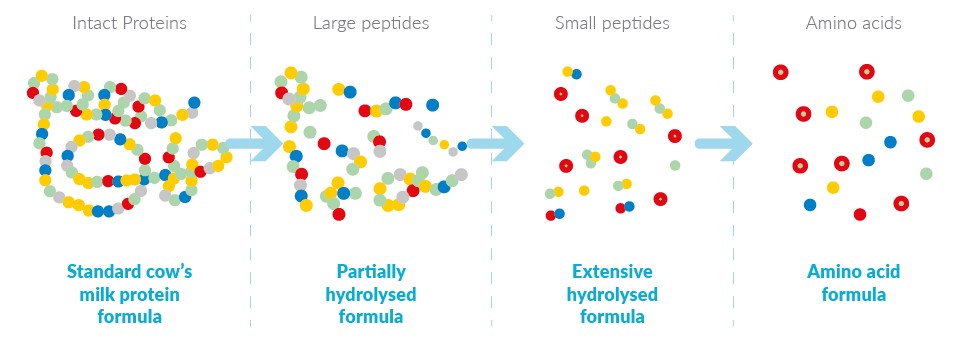
Carbohydrate Source:
Alimentum RTF and Puramino have different carbohydrate sources in their formulations.
Alimentum RTF contains modified tapioca starch and sugar as its carbohydrate sources. Modified tapioca starch is a modified form of tapioca starch, which is derived from the cassava plant. The addition of sugar provides an additional source of carbohydrates for the formula. The use of these carbohydrates helps provide the necessary energy for the baby’s growth and development.
On the other hand, Puramino utilizes corn syrup solids and modified tapioca starch as its carbohydrate sources. Corn syrup solids are made from corn starch and are used to provide carbohydrates and energy in the formula. Like Alimentum RTF, Puramino also includes modified tapioca starch as a carbohydrate source.
Fat Source:
In terms of fat sources, Alimentum RTF contains a combination of safflower oil, soy oil, and medium-chain triglycerides (MCT oil) as its fat sources. These fats are selected to provide a blend that is easily digestible and suitable for infants with cow’s milk protein allergy or sensitivity. Safflower oil and soy oil are rich in essential fatty acids, which are important for the baby’s growth and development. MCT oil is a type of fat that is easily absorbed and can be beneficial for infants with fat malabsorption issues.
On the other hand, Puramino utilizes high oleic sunflower oil, soy oil, and medium-chain triglycerides (MCT oil) as its fat sources. High oleic sunflower oil contains a high concentration of monounsaturated fats, which are considered heart-healthy. This blend of fats in Puramino aims to provide a well-balanced source of essential fatty acids for infants with severe cow’s milk protein allergies or multiple food allergies.
Related: Alimentum Vs Gerber Extensive HA: Which Formula is The Best?
Prebiotics:
Regarding prebiotics, Puramino doesn’t have one but Alimentum has the 2′-Fucosyllactose (2FL HMO) which is a prebiotic found in human breast milk and is part of the group of human milk oligosaccharides (HMOs). It serves as food for beneficial gut bacteria, promoting the growth of probiotics. This prebiotic activity helps support a balanced gut microbiome, which is crucial for healthy digestion and overall immune function.
By incorporating 2′-Fucosyllactose (2FL HMO) in Alimentum RTF, the formula may offer an enhanced nutritional profile and promote gut health for infants with cow’s milk protein allergy or sensitivity.
Nutrition Comparison:

Nutrients:
Alimentum RTF and Puramino offer distinct nutrient compositions catering to different infant needs. Alimentum RTF provides higher levels of fat, sourced from safflower oil, soy oil, and medium-chain triglycerides (MCT oil). This rich fat content offers concentrated energy to support healthy growth and development in infants.
In contrast, Puramino focuses on higher levels of protein and carbohydrates. Puramino’s carbohydrate sources are derived from corn syrup solids and modified tapioca starch, providing the necessary energy for the baby’s growth and development while remaining gentle on sensitive digestive systems.
Related: Alimentum RTF Vs Alfamino: Which One To Choose?
Vitamins:
Alimentum RTF’s higher levels of vitamins E, K, B12, niacin, pantothenic acid, and biotin contribute to the formula’s nutritional profile, providing essential nutrients for the baby’s growth and development. These vitamins play crucial roles in various bodily functions, such as supporting the immune system, promoting blood clotting, and assisting in energy metabolism.
Puramino’s focus on higher levels of vitamins D, C, B1, folic acid, choline, and inositol aims to provide adequate nutrition for infants with severe cow’s milk protein allergy or multiple food allergies. Vitamin D is essential for bone health and calcium absorption, while vitamin C supports the immune system. Vitamin B1 is involved in energy metabolism, and folic acid is vital for cell division and growth. Choline and inositol play essential roles in brain development and overall nervous system health.
The different vitamin compositions in each formula are carefully formulated to address the specific nutritional needs of infants with different dietary requirements.
Related: Alimentum RTF Vs Neocate: Full Comparison (With Charts)
Minerals:

Alimentum RTF’s higher levels of phosphorus and potassium contribute to the formula’s nutritional profile, supporting various bodily functions. Phosphorus is essential for bone health, energy metabolism, and cell growth, while potassium is crucial for heart health and maintaining proper fluid balance in the body.
Puramino’s focus on higher levels of calcium, magnesium, zinc, manganese, selenium, chloride, and sodium aims to provide infants with severe cow’s milk protein allergy or multiple food allergies with the necessary minerals for healthy growth and development. Calcium is vital for bone formation and muscle function, while magnesium plays a role in enzyme activity and nerve function. Zinc supports the immune system and wound healing, while manganese is involved in bone development and metabolism. Selenium functions as an antioxidant, safeguarding cells from potential damage. Chloride and sodium are important for maintaining electrolyte balance and nerve function.
The different mineral compositions in each formula are carefully formulated to cater to the specific nutritional needs of infants with different dietary requirements.
Price and Size Comparison:
| ALIMENTUM | PURAMINO |
|---|---|
| 34.84 $ 12.1 oz 2.88 /oz Buy HERE | 44.82 $ 14.1 oz 3.18 /oz Buy HERE |
| 12.79 $ 32 fl oz 40 ¢/fl oz Buy HERE at Walgreens 13.12 $ 32 fl oz 41 ¢/fl oz Buy HERE at Walmart | – |
Puramino is more expensive than Alimentum RTF because of several reasons;
First of all, Puramino is an amino acid-based formula, which means that the proteins in the formula are broken down into individual amino acids. This complex production process, which involves creating the formula from scratch using amino acids, is more expensive than the process of extensively hydrolyzing proteins in Alimentum RTF.
Moreover, the specialized ingredients can incur higher costs when compared to the ingredients used in extensively hydrolyzed formulas like Alimentum RTF.
Furthermore, Amino acid-based formulas like Puramino cater to a smaller market segment compared to extensively hydrolyzed formulas like Alimentum RTF. The lower demand for Puramino may result in higher production costs per unit.
Finally, Specialized formulas like Puramino may have limited availability compared to more commonly used formulas like Alimentum RTF. Distribution and logistics costs may impact the overall price.
How to Switch From Alimentum to Puramino?
Switching from Alimentum to Puramino should be done gradually and under the guidance of a pediatrician. Here are some general steps to consider when making the switch:
- Consult with Your Pediatrician: Before making any changes to your baby’s formula, schedule an appointment with your pediatrician. They will assess your baby’s specific needs, allergies, and health conditions to determine if a switch to Puramino is appropriate.
- Start Gradually: If your pediatrician approves the switch, begin by gradually introducing Puramino while continuing to use Alimentum. Start with mixing a small amount of Puramino with Alimentum in the same bottle. Over the course of several days, gradually increase the proportion of Puramino and decrease the amount of Alimentum.
- Observe for Reactions: Monitor your baby closely during the transition period. Look for any signs of discomfort, allergic reactions, or digestive issues. If you notice any adverse reactions, consult your pediatrician immediately.
- Complete the Transition: Continue to increase the proportion of Puramino until your baby is fully on the new formula. This transition period may take a few days to a week, depending on your baby’s tolerance and response.
- Follow Feeding Guidelines: Ensure you are following the mixing instructions on the Puramino packaging. Different formulas may have varying preparation guidelines, so it’s essential to follow the specific instructions for Puramino.
- Be Patient: Some babies may take some time to adjust to the taste and texture of a new formula. Be patient and give your baby time to adapt to the change.
- Dispose of Old Formula: Once the transition is complete, dispose of any remaining Alimentum formula, as it is not suitable for your baby’s current needs.
Always consult with your pediatrician or healthcare professional to determine the most suitable formula for your baby’s unique needs. They can offer personalized advice and guidance based on your baby’s health and condition.

